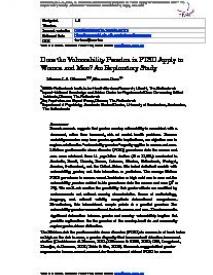Does the Vulnerability Paradox in PTSD Apply to Women and Men? An Exploratory Study
Abstract
Recent research suggests that greater country vulnerability is associated with a decreased, rather than increased, risk of mental health problems. Because societal parameters may have gender-specific implications, our objective was to explore whether the “vulnerability paradox” equally applies to women and men. Lifetime posttraumatic stress disorder (PTSD) prevalence data for women and men were retrieved from 11 population studies (N = 57,031): conducted in Australia, Brazil, Canada, France, Lebanon, Mexico, Netherlands, Portugal, Sweden, Switzerland, and the United States. We tested statistical models with vulnerability, gender, and their interaction as predictors.
The average lifetime PTSD prevalence in women was at least twice as high as it was in men and the vulnerability paradox existed in the prevalence data for women and men (R2 = .70). We could not confirm the possibility that gender effects are modified by socioeconomic and cultural country characteristics. Issues of methodology, language, and cultural validity complicate international comparisons. Nevertheless, this international sample points at a parallel paradox: The vulnerability paradox was confirmed for both women and men. The absence of a significant interaction between gender and country vulnerability implies that possible explanations for the paradox at the country-level do not necessarily require gender-driven distinction.
Geachte bezoeker,
De informatie die u nu opvraagt, kan door psychotraumanet niet aan u worden getoond. Dit kan verschillende redenen hebben,
waarvan (bescherming van het) auteursrecht de meeste voorkomende is. Wanneer het mogelijk is om u door te verwijzen naar de bron
van deze informatie, dan ziet u hier onder een link naar die plek.
Als er geen link staat, kunt u contact opnemen met de bibliotheek,
die u verder op weg kan helpen.
Met vriendelijke groet,
Het psychotraumanet-team.
In: Journal of traumatic stress, ISSN 0894-9867 | 30 | 2 | April | 200–204
http://doi.org/10.1002/jts.22173


